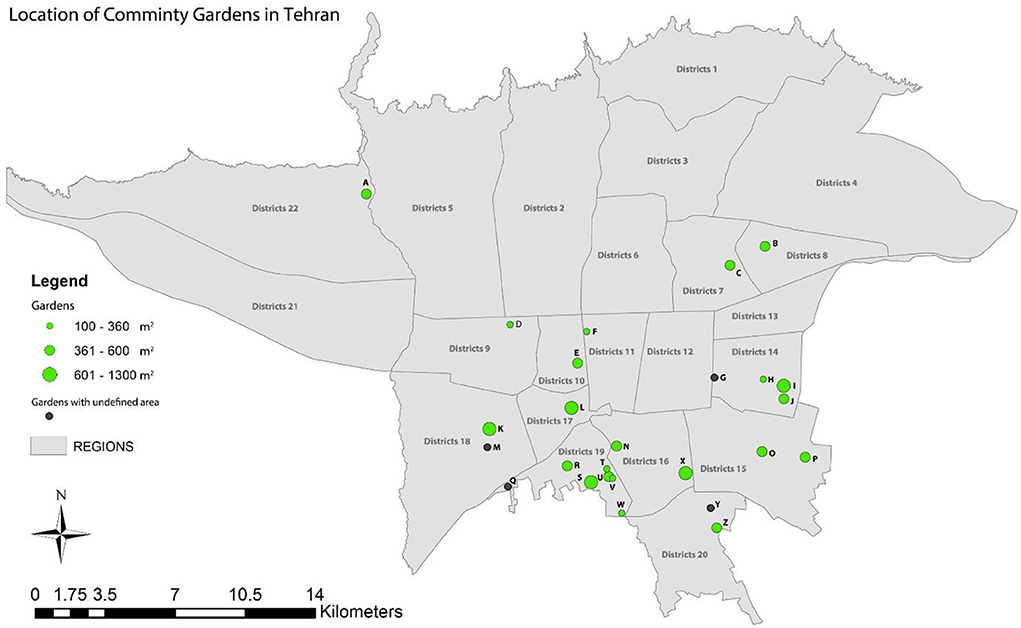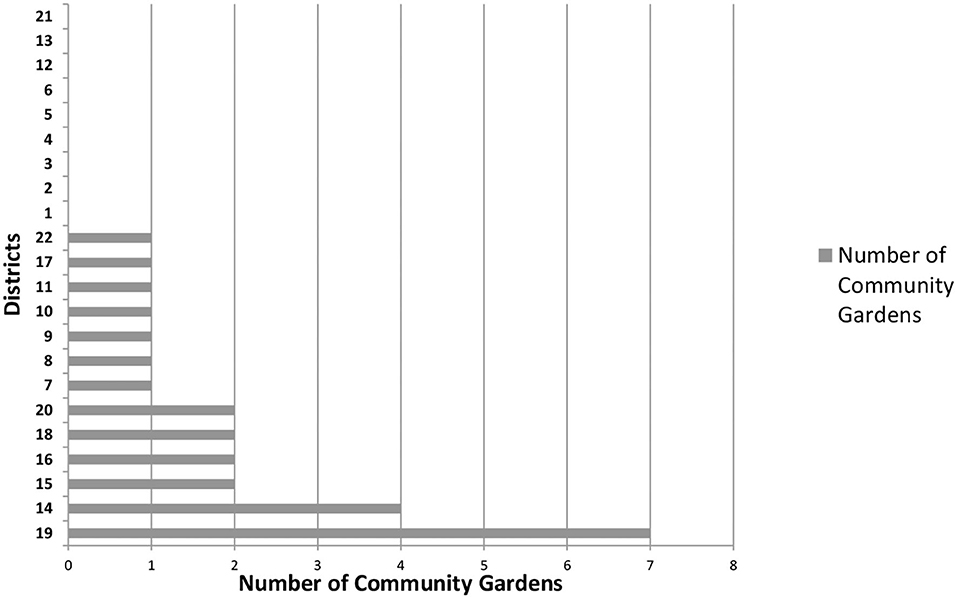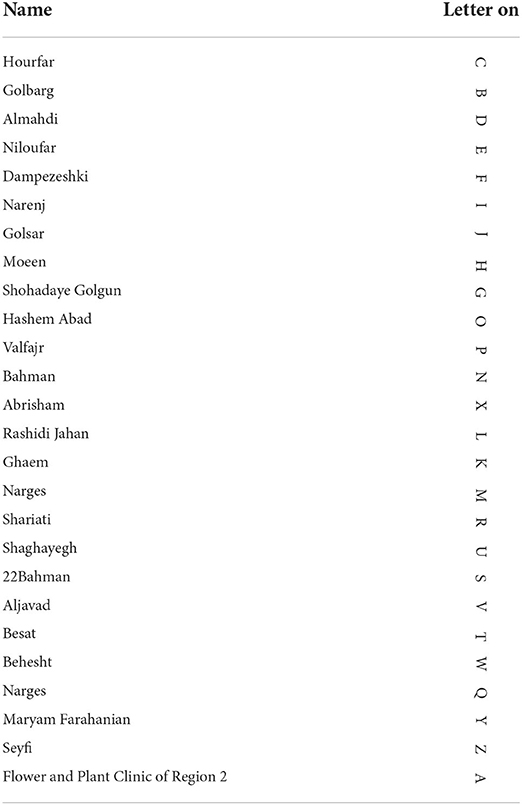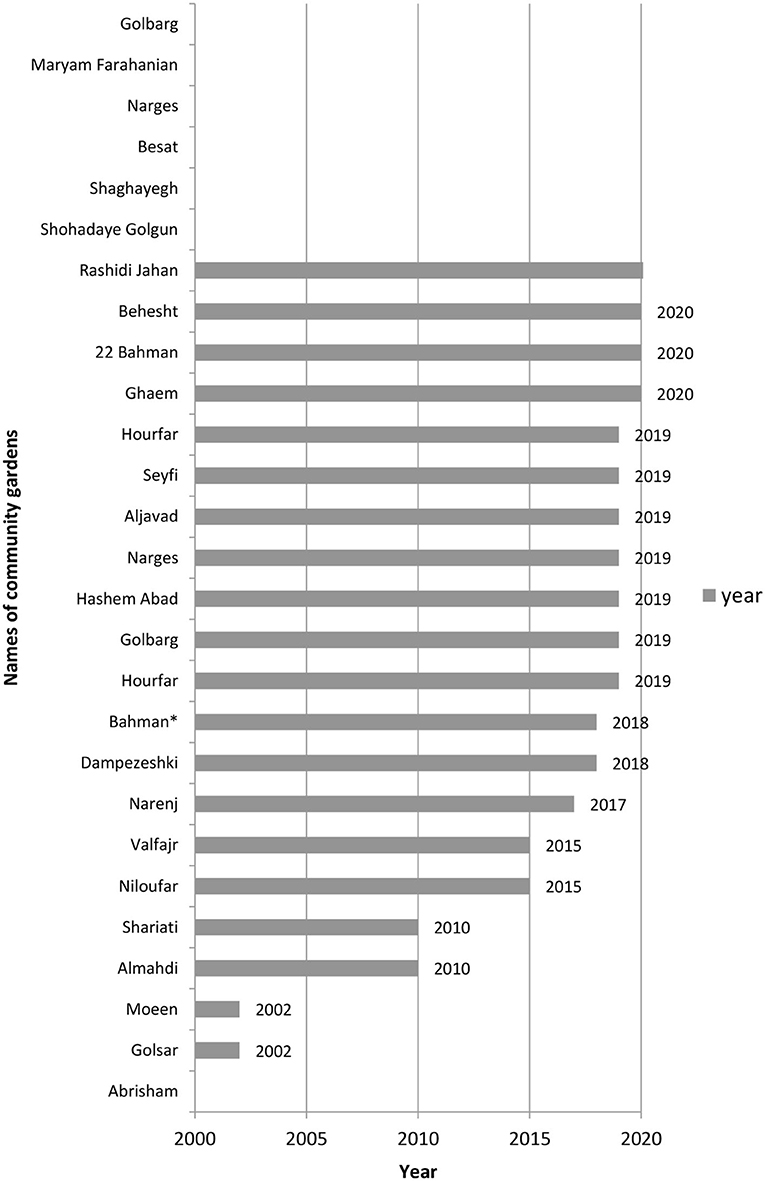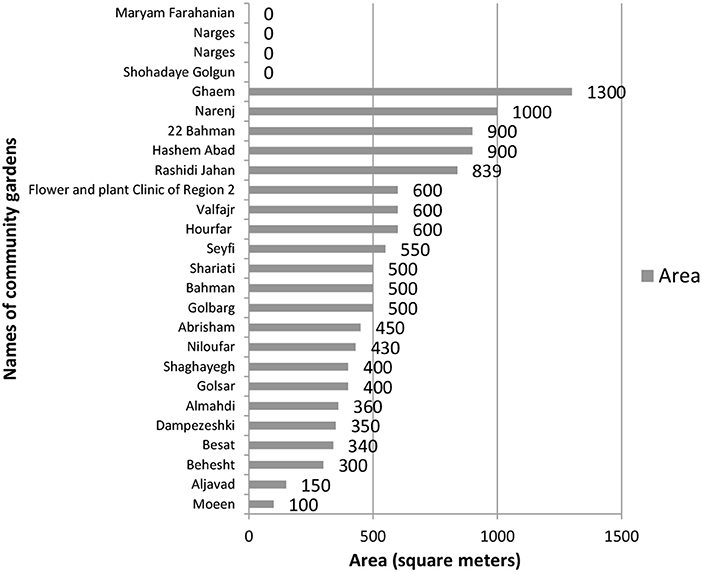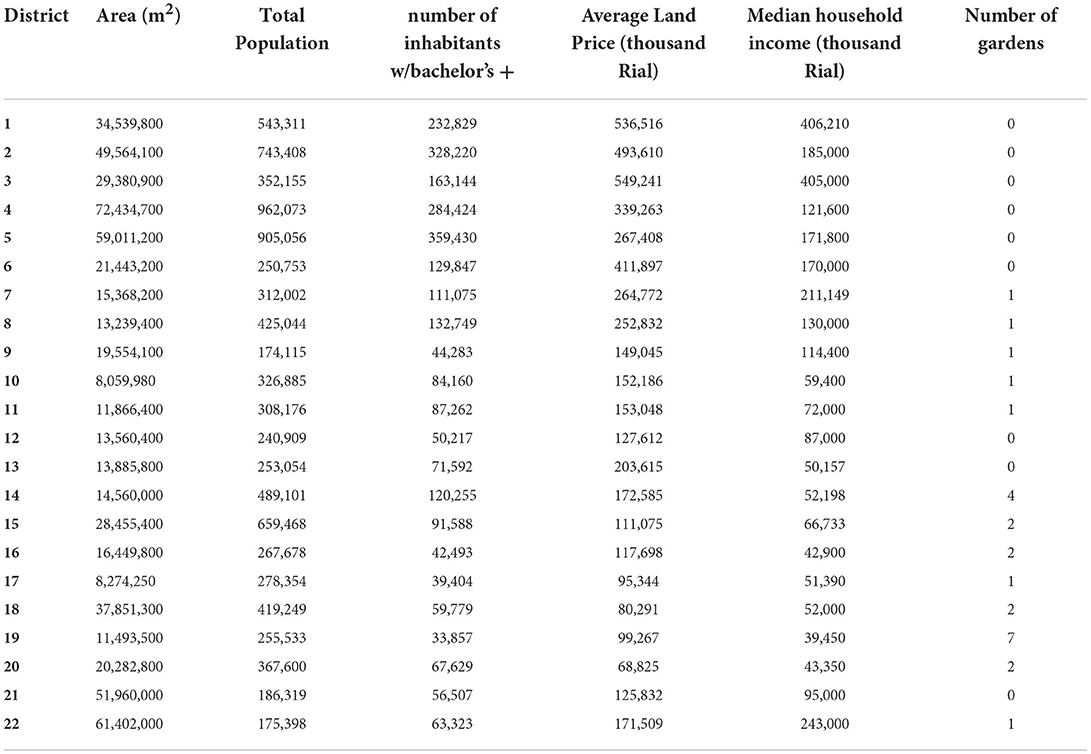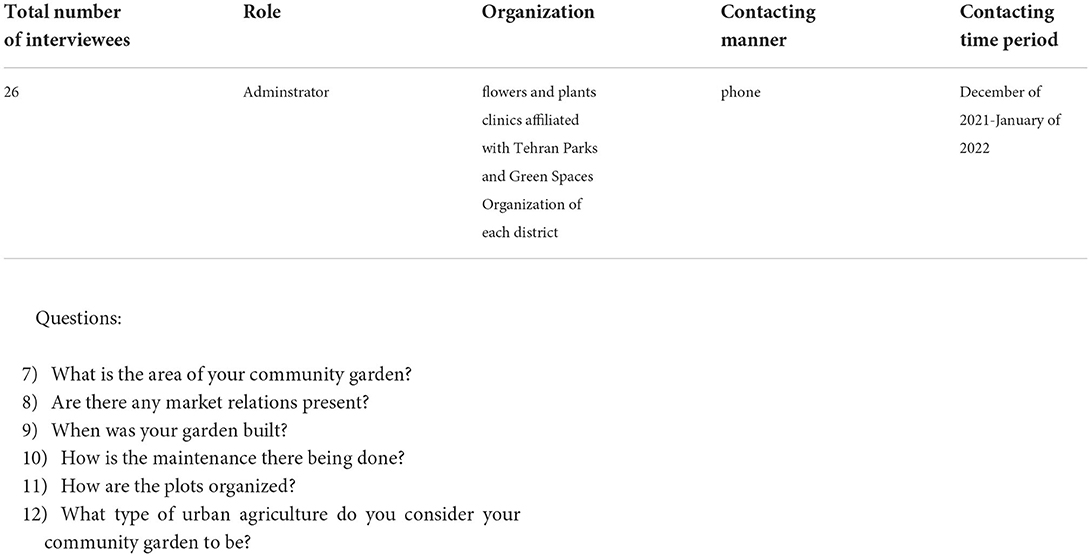- 1Temple University, Philadelphia, PA, United States
- 2Shahid Rajaee Teacher Training University, Tehran, Iran
Urban community gardens are a type of green space presenting a diverse role in urban systems. They can also be beneficial for solving the matter of food insecurity by providing self-sufficiency and resilience in low-income communities and increasing the continuity of agricultural activities. Even though plenty of research has been conducted around community gardens, there is a noticeable research gap concerning case studies in different geographic contexts, especially in the Middle East. This paper in response to the said gap aims at mapping the spatial distribution of community gardens and their socio-economic attributes in Tehran, Iran. A methodology consisting of semi-structured interviews, qualitative and descriptive analysis along with tools such as ArcGIS was employed and secondary data were obtained from various sources such as the Tehran statistical yearbook of the year 2020. The results demonstrate that currently there are a total of 26 community gardens in Tehran and they run based on governmental funds and support with a strong educational motive backing them up. There is also an evident geographical distribution imbalance in terms of gardens placement with them mostly being present in the southern part of the city, while in the northern districts the idea of community gardens has almost been nonexistent. Only districts 22, 8, and 7 among northern districts in Tehran have community gardens. In the southern part, district 19 includes the majority of gardens having seven in total. In short, gardens are mainly placed in areas with lower average land prices, median household income, and higher education graduates.
Introduction
As the cities become more and more populated and complicated, the need for creating multi-functional entities able to respond to different urban issues emerges. Urban community gardens are a type of green space where people seek outdoor recreation, interaction with nature (Russell et al., 2013), and resources for collectively cultivating food (Butterfield, 2020), thus presenting a diverse role in urban systems. The kind of community gardens that we have come to know today, date back to the 1970s era in North-east American industrial cities. The post-Fordism period left cities with an abundant amount of left-out space as a result of them not turning industrial. The increasing rate of unemployment led to conflict between people and those in power. In this crisis era, community gardens appeared to respond to social and economic problems by creating a sense of community and food production (Exner and Schützenberger, 2018).
The way that the idea of community gardens was formed shows what an essential role it plays and since its creation, the many positive impacts associated with them have been proven and studied. They even benefit the environment by conserving resources through shortening the commodity chain, resulting in saving on fuel demanding transportation and packaging, decreasing air pollution through the gas exchange systems of leaves and soils, mitigating heat island effects proceeding in lower consumption of energy, and reducing environmental footprint (Tsilini et al., 2015; Iuliano et al., 2017: 26; Rusciano et al., 2020: 11; 1). Community gardens can also bring along health benefits, either mental or physical (Teig et al., 2009; Zoellner et al., 2012; Alaimo et al., 2016; Butterfield, 2020: 738; Draper and Freedman, 2010), and studies have suggested that community gardens can offer opportunities for increased physical activity that can result in better physical health in citizens (Barnidge et al., 2015; Baker et al., 2016; Malberg Dyg et al., 2019) and they not only provide space for exercising but also the act of gardening itself can be interpreted as a form of physical activity (Park et al., 2014; Wells et al., 2014), as well as contribute to improved diets of their users (Lovell et al., 2014: 3; Butterfield, 2020: 758).
Beyond health advantages, researchers have reported a wide range of socio-economic benefits concerning Community gardens. They are known to create and enhance social capital through the development of collective efficacy, a sense of community, neighborhood pride and morale, social ties, increased appreciation of social diversity, and civic engagement (Kingsley et al., 2009; Anderson et al., 2019: 671; Ochoa et al., 2019: 2; Russ and Gaus, 2021: 6). By increasing the sense of community that can produce ownership and stewardship, community gardens have also been responsible for crime prevention (Garrett and Leeds, 2014: 212). For instance, in Houston, Texas through interviews with community gardens users, it was realized that the presence of gardens produced safer and crime-immune neighborhoods (Gorham et al., 2009: 295). In terms of economic advantages, community gardens have been shown to increase property values in the immediate vicinity where they are located, the productivity of vacant lands, the value of food produced, and finally reduce expenditure on food for gardeners (Lovell et al., 2014: 3).
Even though plenty of research has been conducted regarding community gardens and their advantages, there is a noticeable research gap concerning case studies in different contexts, especially in the Middle East. Documents about community gardens are not uniformly distributed with the United States being mainly the study area (Guitart et al., 2013: 7). A recent article authored by Graefe et al. (2019) concerning trends and gaps in urban and peri-urban agriculture in 2019 found that the Middle East and North Africa appear the least in the scientific literature with only holding 1.9% in the whole urban agriculture research movement. Moving from the global context, the national research scene also has shown little interest in the subject of community gardens with related studies revolving around the evaluation of the suitability of Iranian historical gardens for modern urban agriculture (Khalilnezhad and Tobias, 2016; Amani-Beni et al., 2021; Khalilnezhad et al., 2021), while exploring the current community gardens and their associated attributes have been neglected. In fact, identifying the real socio-economic status of neighborhoods and their associated community gardens needs an evidence-based and experimental study in which all parameters can be examined through data collection and synthesis (Razzaghi-asl and Zarei, 2014).
To address the geographical gap, this paper aims at mapping the spatial distribution of community gardens and their socio-economic attributes in Tehran through an experimental study, the capital city of Iran where the idea of community gardens has not been properly contemplated. This research offers one of the first analysis of community garden locations in Iran to produce a more comprehensive and detailed understanding of the relationship between the social and economic composition and garden locations which can help urban planners and policymakers better utilize community gardens in developing countries.
Addressing food insecurity through community gardens
Food security is a situation that exists when all people, always, have physical, social, and economic access to sufficient, safe, and nutritious food that meets their dietary needs and food preferences for an active and healthy life (Peng and Berry, 2018: 1). Food insecurity, moreover, is defined as a state in which people are not able to provide nutritious valuable foods for themselves or their families (Gundersen and Ziliak, 2015: 1830). As it can be observed from these definitions, it is important not to mistake food insecurity with hunger as food insecurity can exist without starvation, and another tip obtained is the importance of accessibility and nutritious value while talking about food insecurity and ways to diminish it. Food insecurity is mostly seen in low-income families as they often choose energy-dense foods high in sugar and fat and low in nutrients as a way of stretching their food budget. As a result, this can lead to numerous negative consequences such as decreased mental and physical health and increased risk of diagnosis with chronic illnesses such as diabetes and obesity proceeding to higher healthcare costs (Tarasuk et al., 2015). Common measures used to combat food insecurity include governmental assistance programs that despite being valuable and somewhat effective, mostly lack enough funding and accessibility, and do not always ensure the delivery of a sound and nutritious diet. Therefore, it is necessary to find long-term and more resilient solutions. Community gardens in contrast to the mentioned top-down solutions are the kind of collaborative and bottom-up efforts facing the problem (Okvat and Zautra, 2011) posing as a more sustainable tactic.
Several studies have pointed out the positive impact of community gardens on the issue of food insecurity (Shisanya and Hendriks, 2011; Guitart et al., 2013; Pascoe and Howes, 2017: 381, 387; Souza et al., 2019: 2; Vidal Merino et al., 2021: 14; Castellarini, 2022: 3). Gardens become beneficial for solving the matter of food insecurity by providing self-sufficiency and resilience in low-income communities (Van den Berg et al., 2010) and increasing continuity of agricultural activities which is a significant part of creating food security (Viana et al., 2022). For instance, Algert et al. (2016) in a study exploring the role of community gardens in improving the vegetable consumption of residents in San Jose, US reported that the presence of community gardens doubled their vegetable intake and met the number of daily servings recommended by the U.S. dietary guidelines. In another research taking place in rural Oregon, food insecurity concerns decreased from 31 to 3% among participants in community gardens (Carney et al., 2012). Baker et al. (2013) found that the presence of a community garden in Missouri, US affected their diets positively, decreasing the fast-food intake and money spent on food. According to Maunder and Meaker (2009), children from households that participated in agriculture experienced better intakes of several nutrients. Community gardens have also been shown responsible for cost savings among garden members (Algert et al., 2016) and this leads to having the ability to buy the food with extra savings that one could not do in the absence of community gardens. Further “economic impacts include increased property value in adjacent neighborhoods, increasing the productivity of vacant lands, and the value of food produces” (Been and Voicu, 2007) once again resulting in a positive contribution to food security though in a less direct way.
Spatial distribution of community gardens
Several studies have explored the spatial distribution and placement of community gardens within a region or a city. Butterfield in 2020 to examine the relationship between neighborhood composition and community gardens locations, employed negative binomial and spatial regression methods and findings demonstrated that higher aggregate concentrations of black and/or Latino residents, lower-income residents, and well-educated residents regardless of ethnicity or income, reveal increased numbers of gardens. In a similar study, Iuliano et al. (2017) presented a case study of urban community gardens in southeast Michigan and created socio-economic profiles of communities surrounding gardens by census land cover data to discern patterns in garden placement. In general, results showed that gardens were evenly dispersed across communities with varying socio-economic attributes, indicating that other factors, such as land availability, may be greater determinants of garden locations. In another article also based on the US, Anderson et al. (2019) used garden locations provided by stakeholder groups and fine-scale spatial data to compare community gardens across New York City, Chicago, and Baltimore, thus providing a critical insight into the typology in and around community gardens in different cities, which is useful for understanding the potential ecosystem services and planning systems of those cities. Transferring the attention from North America to other cases, it is worth noting to mention research handled by Borčić et al. (2016) which applied a comparative manner and studied the placement and differences between community gardens in Zagreb in two specific economic and socio-cultural contexts reflecting the contrasts and similarities between gardens of socialists and post-socialist eras. The results reached by using methods such as semi-structured interviews showed that in post-socialist Zagreb, the new gardens were depicted as beacons of communal involvement, grassroots movement, and the ability of citizens to stand together and subsequently develop a valuable social capital.
As previously mentioned, one of the major issues leading to food insecurity arises from lack of access, the uneven distribution of food supply, and inadequate income rather than insufficient food production (Sharkey, 2009). Growing food in community gardens can contribute to fighting food insecurity by providing availability and access to fresh greens thus increasing its consumption and forming a healthier diet among fellow members of the community and also educating gardeners about healthy eating and cooking impacting their food intake (Algert et al., 2016: 77) This accessibility is either beneficial to the gardeners themselves as growing food can meet their own food needs or they can be donated to food-insecure families. For instance, between the years 2005 and 2009, nearly 19 million pounds of local produce was distributed through 307 CFPCGP projects in the United States (Kobayashi et al., 2010).
Another important factor that should be noticed is the “even” spatial distribution of community gardens in a city. Life in distressed urban neighborhoods is often paired with negligence toward infrastructure and services (Anguelovski, 2013: 1) and the unavailability of community-supported agriculture (McIlvaine-Newsad and Porter, 2013: 69), resulting in undesirable outcomes such as the absence of proper green open spaces like community gardens for citizens. In recent years, though there have been several initiatives attempting at organizing the focus on accessible green and recreational spaces and urban gardens to fight neighborhood degradation and abandonment, changing the direction of environmental justice which is traditionally concentrated on brown cases of injustice, shifting it more toward green cases aiming at create livability via parks or urban agriculture (Anguelovski, 2013).
Considering the many benefits that come along with community gardens and their ability to address lots of issues in an urban area, it is here that we should emphasize the role of distributive justice which has been defined by Cook and Hegtvedt (1983: 218) as a type of justice principle concerning “general fairness in allocation situations.” Therefore, it is important for us to assume the necessary need of building community gardens in all parts of a city and distributing them in a way that citizens from different groups of the society and having different conditions, regardless of their socio-economic status, have easy access to them and can benefit from through participating in gardening activities.
Barriers and challenges of community gardening in Iran
Despite the existence of abundant studies showing the positive effects of community gardens, they exhibit the challenging side to this matter as well. These hinder community gardens' way of responding well to the food insecurity issue. Monetary costs such as start-up or equipment are a major obstacle ahead for people suffering from food insecurity because they have limited disposable incomes (Wesener et al., 2020: 16). Many citizens who want to garden are not well familiar with gardening and this lack of skills and knowledge may have undesirable results at the end (Filkobski and Rofé, 2016). The absence of proper management and long-term planning and crime has also been threatening agents to community gardens' success, namely, theft and vandalism (Kingsley et al., 2020). Another danger to gardens is growing products on land that are potentially contaminated; it is due to the fact that community gardens are often placed on undesirable vacant lots such as brownfields (Adorján et al., 2015: 48). Community gardens also have to face the challenge of land tenure, making them vulnerable to sudden changes in the availability of their plots for gardening (Guitart et al., 2013). A limited workforce and bad weather such as sudden storms and drought resulting in the destruction of produce on land is another issue pointed out by participants (Diekmann et al., 2017). In regard to food donation, sometimes gardeners grow vegetables that one cannot find in grocery markets; in other words, they are exotic making them undesirable for donations as most of the people who get this help prefer staple foods. The products are also commonly seasonal; thus, the positive effect is not stable throughout the year.
Community gardens in Iran have also not been immune from the general difficulties mentioned above, but several challenges subject them specifically in Iran. Hamidi and Yaghoubi, in a research paper in 2017 by conducting a comprehensive survey, in which agricultural experts participated, obtained the important challenging factors that were specific to community gardening in Iran. They found that the lack of legal, financial, and educational support, lack of educational agricultural courses and weakness in terms of knowledge and skills, the prevalence of pests and diseases and harassment of pets, lack of proper communication between agricultural institutions and citizens, and finally land deficiency and water are the major shortcomings. In addition, it is apparent that some of these problems are in line with the difficulties that are generally common in community gardens no matter where they are placed, but out of these, the environmental issues seem to be more crucial to Iranian community gardens, since the issues of water sacristy and air pollution have been getting worsened in the past recent years (Gorjian and Ghobadian, 2015).
Methods
Study area
Tehran, the capital city of Iran and the center of Tehran province, as shown on Figure 1 where our research ensues. This city lies in the northern half of Iran and has three different climatic types (Northern Highland, mountainside, and dry-semi dry), thanks to the presence of a desert plain to the south and the Alborz range to the north of its location, resulting in a roughly 3,000 m height difference between the highest and lowest points (Kasmai, 2004). Currently, Tehran has a population of around 8.6 million holding 10%of the total population of Iran. Tehran has substantially higher rates of median household income with an annual median income of 443,603 thousand rials and a higher education rate by holding 3,143,273 graduates as opposed to national numbers of 317,210 thousand rials and 13,613,651 in those regards, respectively (Iran Statistical Center of Iran, n.d.). This city by having a relatively large area of land coverage and vast differences between its several different districts and also diversity of its population can function as a prime setting for analyzing the association between socio-economical compositions.

Figure 1. Study location; from right to the left: country of Iran, Tehran Province, Tehran City and its districts.
Currently, community gardens in Tehran are commonly known as “family gardens.” A few years before the formation of a more formal outlook toward community gardens and urban agriculture in general, they were and even now are developed as a by-product of gardening classes held in flowers and plants' clinics which are subsets of Green Space Education and Consulting Research Centers in municipalities. These clinics are adjacent to parks in Tehran and are responsible for activities related to green space and gardening due to the nature of their work and needing plots of land to teach citizens about gardening in their classes, and small areas in parks were given to clinics and through time participants and size of plots grew, though it was not always the case and a handful of these types of gardens now have been diminished as a consequence of issues such as land ownership. Since most of the current gardens work under the supervision of clinics affiliated with municipalities, they are considered the type of urban gardens enforced by public and governmental sectors. In 2021, a guide covering regulations regarding urban agriculture was issued by the Ministry of Roads and Urban Development and its main goal is to shed a sort of legitimacy light on the activities of community gardens in Tehran which will support them when facing issues and provide the possibility of an increase in funding.
Data collection
We can break down the data collection procedure into three main steps, starting with interviews with the municipalities, then gardens, and lastly acquiring secondary data from different reliable sources. First, a qualitative methodology was employed in this research by using semi-structured interviews (refer to the Appendix for more details). Primarily, it was necessary to figure out if each district in Tehran has community garden or gardens within themselves, and then it was important to find their geographical location in that specific district. As it was mentioned in the study area section, community gardens in Tehran work under the supervision of organization of parks and green spaces affiliated with the municipalities, therefore, in order to identify the possible presence of gardens and their locations, we reached out to each district's municipality office via phone and spoke to their public relations representatives between October and November of 2021 with each phone call lasting around 5 min, while below questions were asked:
(1) Does your district include any community gardens?
(2) Where are the community gardens in your district located?
Tehran has 22 districts, so 22 phone calls to municipality offices were made in total. Out of these, nine districts alleged that no community gardens are present there, so they were crossed off the list. In the second stage in order to recognize each garden in more detail, the authors defined several attributes that had to be addressed regarding each of the gardens, namely, the presence of market relations, maintenance, plots' type, type of urban agriculture, area, and starting year. In order to find this particular information, we again employed the previous method by calling each community garden's administrator individually. Previously by talking to districts' municipalities, we had found out that 26 gardens are currently present in Tehran, thus at this stage, 26 phone calls were made, lasting around 5–10 min occurring between December 2021 and January 2022, in which we were able to talk to the administrator of each garden and ask the following questions:
(1) What is the area of your community garden?
(2) Are there any market relations present?
(3) When was your garden built?
(4) How is the maintenance there being done?
(5) How are the plots organized?
(6) What type of urban agriculture do you consider your community garden to be?
The last step of the data collection process mainly dealt with socio-economical characteristics of each district in Tehran. We derived data related to the total population, literacy rate, and land price from the Tehran statistical yearbook of the year 2020 that is publicly available and extracted the individual household income data of each district from the annual raw income data provided by the Statistical Center of Iran.
Data synthesis
The primary goal of this study was to determine the general socio-economic and physical attributes and spatial distribution of the community gardens in Tehran. In order to reach this goal and consider the exploratory nature of this paper, a descriptive qualitative analysis was applied to detect possible associations. To present our data produced in the data collection section in a way that is suitable for analysis, we used Google Earth, ArcGIS, and Excel to produce spatially explicit maps. Figure 2 shows the location of each garden in each district and also their different land areas in square meters which was done through the symbology function in ArcGIS.
In order to combine the secondary data and the placement of the gardens in map formats, in ArcGIS 10.3.1 environment for the shape file consisting of the gardens' layer on top of the city of Tehran's layer, those census data were put into the attribute table. Then four separate maps along with their specific legends were produced, with each demonstrating one of the four data types, namely, population, average land price, number of inhabitants w/bachelore's +, and median household income in juxtaposition with spatial positions of the gardens, preparing them all for later qualitative and descriptive analysis, as shown in Figure 7, Map (D).
In regards to the individual characteristics of each garden in which its data were driven from stage 2 interviews, we employed Microsoft excel 2010 for presenting the mentioned quantitative data through chart production. In total seven bar charts were produced with each of them separately displaying that specific quality concerned with each garden.
Results
Overview of community gardens distribution
As can be observed from Figures 2, 4, Table 1, in total there are 26 community gardens in Tehran to date and the southern districts of Tehran experience the most quantity of community gardens compared to the northern half of the city. Only districts 22, 8, and 7 among northern districts in Tehran have community gardens. In the southern part, district 19 includes the majority of gardens having seven in total, and following that district 14 stands with four gardens. It seems that although some regions benefit from a relatively high number of present community gardens, their locations and distance from each other are not supported by a logical pattern. For instance, note districts 20 and 18, they both hold two gardens each. But the issue seems to be the distance between gardens since they are not very far apart and are placed on farther sides of the mentioned districts. This misplacement results in other parts of the region as they do not have proper access to community gardens to enjoy their many benefits. The Figure 3 also shows some scenes from the current state of community gardens in Tehran.
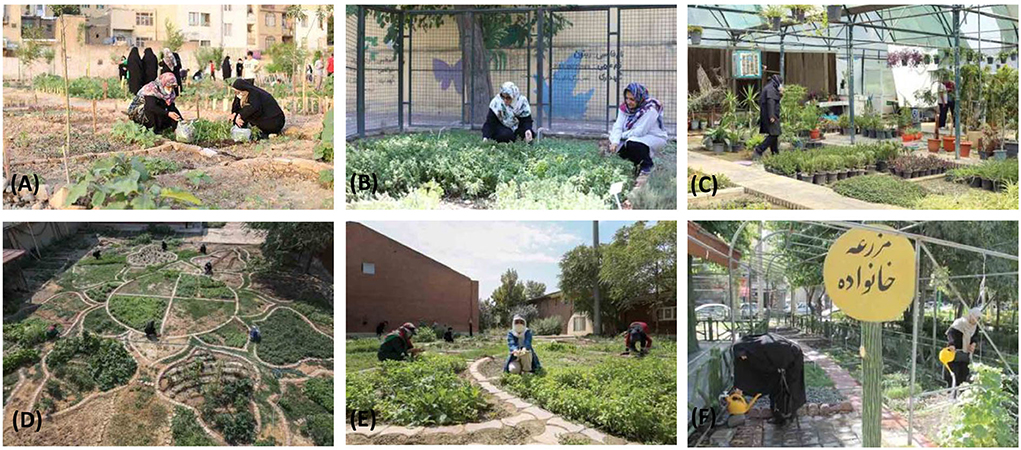
Figure 3. Community gardens in Tehran. (A) Hashemabad garden, (B) Almahdi garden, (C) Hourfar garden, (D,E) Shariati garden, and (F) Almahdi garden.
The time course as demonstrated in Figure 5 shows that the execution of community gardens in Tehran is quite a fairly new idea with the oldest of them dating back to 2002 and the acceleration of their creation has only happened in the past few years (out of 26 present gardens in Tehran, 16 of them have been constructed in less than a decade ago, see Figure 5). Since there has not been much comprehensive research conducted in regards to community gardens in Tehran, it was difficult to gather eligible data; thus, the authors were fronted with the only option of contacting each garden individually and doing interviews. Speaking of different features that community gardens in Tehran possess, it seems proper to first address their mutual characteristics. Skimming the data in Figure 6 shows that Ghaem garden in district 18 with 1,300 m2 is the largest and Moeen garden in area 14 with 100 m2 is the smallest community garden in Tehran. Surprisingly enough, a strong presence of market relations can be perceived as well, with 14 gardens in total reporting to have those relations Many of the plant and flower clinics that are responsible for community gardens have claimed that often surplus of the product yielded is sold to external markets by gardeners. This relation though is not organized, it is usually performed by volunteer gardeners themselves. Also in terms of plot type, 21 out of the whole 26 gardens have claimed to have individual plots on their agricultural land, with each plot being separated from the other for the ease of users' activities.
Summarizing the data provided in Figure 2, and interviews with gardens' administrative, a common community garden in Tehran is located next to the building of plant and flower clinics and the motive behind their creation is mostly educational, providing land for gardening classes held at mentioned clinics. The plots are mostly individual with every piece of land belonging to one citizen who will be responsible for caring for their part. The maintenance is supported financially by the governmental fund; as a result, gardeners are able to work on rent-free land and use pieces of equipment that have also been provided free of charge. It is apparent that the government sector is very active in creating and managing all the aspects of community gardens in Tehran though the emergence of two neighborhood gardens in districts 19 and 20 in 2019 is also a milestone, breaking the trend of community gardens being limited to the urban type and solely being managed by governmental sector. Probably this type of community garden will be seen more in future, forming a new direction in the path of urban agriculture in Tehran.
Socio-economic status analysis
Population
Map (A) in Figure 7 demonstrates the geographical distribution of community gardens in Tehran juxtaposed with the total population of each district where they are placed. As evident from that, there is an imbalance of gardens' numbers in terms of the total population of districts. While district 19 holds seven gardens within itself, district 15 with a considerably high population number of 659,468 has only two gardens. This issue gets even more noticeable when we take the size of these two districts into account, since district 15 is about two times as big as district 19, though this unevenness does not end here. In general, if we observe districts lacking community gardens, we will notice that the most populated areas in Tehran-like districts 4, 5, and 2 having population numbers of 962,073, 905,056, and 743,408 correspondingly, also covering a sizable area, are the ones experiencing the absence of gardens.
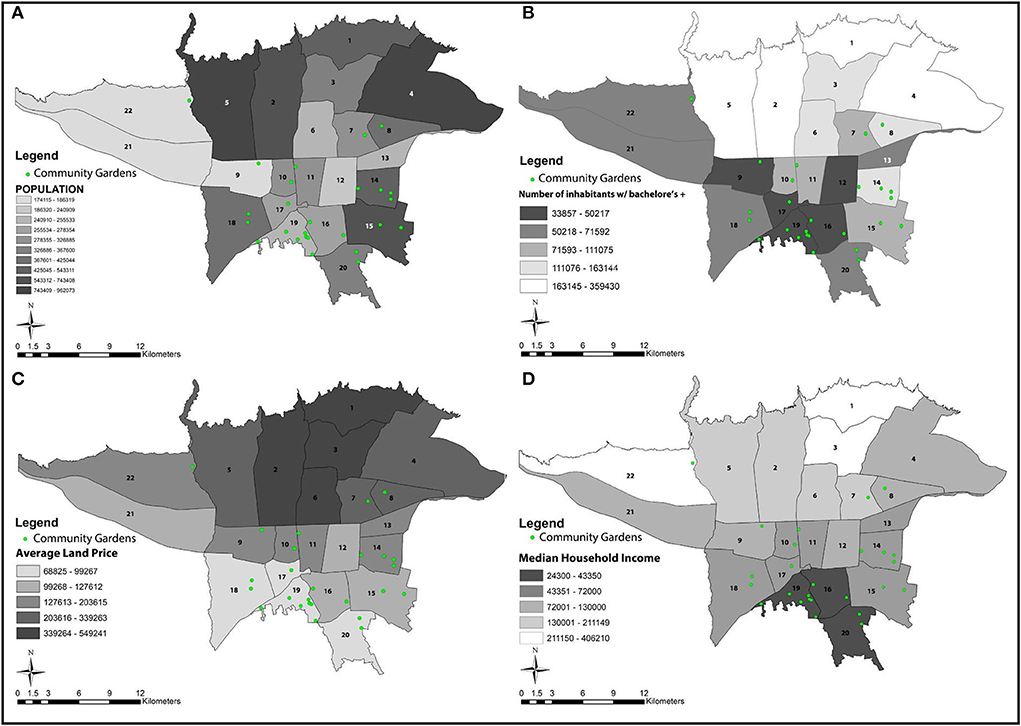
Figure 7. Map of Tehran community gardens by (A) total population of every district, (B) number of inhabitants w/ bachelor's +, (C) average land price in every district, and (D) median household income in Tehran.
Education
Map (B) in Figure 7 provides an overview of the number of inhabitants with higher education in districts of Tehran where gardens are. Reviewing this map alongside information from Table 2, we can observe that community gardens are mostly located in districts with lower rates of higher education. Districts 19, 17, 16, and 9 are the ones with minimum higher education rates of 33,857, 39,404, 42,493, and 44,283, respectively, but they hold 11 out of 26 current present community gardens which are more than a third of the total number. On the contrary, district 5 with the highest number of higher education graduates, lacks the presence of community gardens. Overall, as stated above, solely district 8 has a relatively high number of graduates who benefit from only one community garden present and the general pattern regarding the distribution of community gardens concerning higher education shows that areas with the most educated people are short of them.
Average land price
Through examining map (C) in Figure 7 which illustrates the average land price of districts in Tehran, it is observable that the more expensive the different districts get, the fewer gardens we see there. Districts with the highest number in terms of land price are districts 3, 1, 2, and 6 with an average land price of 549,241, 536,516, 493,610, and 411,897 thousand rials, respectively, own no community gardens, whereas the ones with the lowest land price that are districts 20, 17, 18, and 19 with an average land price of 68,825, 80,291, 95,344, and 99,267 rials, respectively, by having nine out of 26 community gardens in Tehran, hold the majority of gardens. The rest of the total number of the gardens lay in relatively low price districts except districts 7 and 8 which are fairly expensive. The noticeable relationship here seems to be that with growth in the land price, the presence and number of community gardens lessens. Furthermore, as it is apparent from map (B), the north of Tehran is more expensive in terms of land price while the southern part of Tehran has a considerably lower land price and holds the majority of community gardens compared to the north.
Median household income
Map (D) in Figure 7 illustrates the median household income in the districts of Tehran. Districts 1, 3, and 22 are the ones with the highest, and 19, 16, and 20 are with the lowest household income. It seems that as we move from the northern parts of the city to the south, the income decreases significantly; for instance, note that district 1 with the highest income of 406,210 thousand rials a year, which plummets in the most southern district of Tehran, reaches with an income of 43,350 thousand rials in the most southern part of the Tehran (district 20). Though district 19 geographically stands above district 20, it experiences the lowest household income with only 39,450 thousand rials a year. The spatial pattern that household income follows seems to be in opposition to the one that gardens locations show; the further we go from the northern districts to the southern ones as the number of gardens increases, the number of household income drops, notice district 19 with the lowest income in Tehran, holding seven gardens, standing on top of the list of districts with present gardens while district 1, the district with the highest amount of household income, lacks any.
Discussion
After discussing the positive effects that community gardens can have in regard to the issue of food insecurity and also its possible shortcomings, it is evident that we cannot consider community gardens as a panacea that can fight off food insecurity alone. However, if executed right, they can be a compelling component in a comprehensive plan against food insecurity. Some strategies were proposed in the literature review to maximize gardens' effectiveness, such as creating a food hub to connect outside communities to the farm, conducting proper land management/ownership, using the potential of digital technologies to address pain points, planning agricultural educational programs providing skills, and outlook for overall net benefit to gardening by reducing or removing barriers while enhancing the perks, supporting the development of family smallholders, or commercial farming enterprises. But in the end, it is essential to have a moderate approach toward using community gardens as means of defeating food insecurity since a one-dimensional use of them will hinder us from enjoying their many other gains.
The analysis of our case study in Tehran revealed that community gardens in Tehran were located and more extensive in districts of lower population density, hindering citizens residing in more populated areas from enjoying their presence. As it had been pointed out in Anguelovski (2013), this imbalance in terms of gardens' distribution results in the creation of the green type of environmental injustice. But this imbalanced distribution does not end here, as the northern half of the city holds only a few gardens which in comparison to the almost huge number of remaining gardens present in the southern part of the city, seems insufficient and more enforces the idea of spatial injustice. These findings are essential since they remind the importance of equity and considering distributive justice, while the spatial planning stage is being carried out.
Going through the features of gardens as demonstrated by data provided in this article, it is safe to assume that community gardens of Tehran, in general, share many similarities with the most prominent of mutual qualities between them all would first be the presence of a top-down approach toward them and secondly the strong existence of educational motivation behind their creation. This top-down approach has also been pointed out in Eizenberg and Fenster (2015) as they studied community gardens in the cities of Jerusalem and Tel Aviv-Jaffa, where all the gardens were products of the mentioned outlook though initiated by different agents or agendas. The educational motive of community gardens has also been studied several times in the literature thus being in line with our findings. In Tampa, as stated in Marshall et al. (2017), community gardens are places where learning and teaching can take place.
Shifting the attention more toward the analysis of socio-economic data, some major associations were drawn. It seems that when we put the higher education data in perspective, the existence of a negative relationship between the said data and the location of gardens becomes clear. Map B in Figure 6 demonstrates the number of higher education graduates and also gardens within each district in the city of Tehran by examining it, and we can see that as the number of graduates drops, the number of present community gardens in a district increases. This finding is in contradiction with what other studies have implicated; for instance, Butterfield (2020) discovered that areas having more higher education graduates were associated with an increased number of community gardens being located there.
Our analysis of socio-economic parameters of surrounding districts showed a negative association between median household income and average land price of a district and the placement of the gardens in each district. It appears that with dwindling the land price and median household income, we witness more community gardens. This finding is consistent with the results of other similar studies, though some other papers have painted an opposite picture regarding that. Butterfield (2020) indicated that the lower the median household income in an area gets, there will be more community gardens present. Meenar (2017) implied the same thing and assumed that this phenomenon resulted from the lower land price in poorer areas. Moreover, Smith et al. (2013) found that the newer community gardens in Madison were more often placed in areas with medium to high-income rates Finally, Marshall et al. (2017) in line with what was stated before, demonstrated that it was mostly the high-income people that were users and members of community gardens in Tampa Bay, US.
Conclusion
Community gardens are a type of urban agriculture practice, providing many proven benefits. Besides their ecological and social positive points, they can be included in a comprehensive plan against food insecurity since they can bring and introduce healthy fresh ingredients to their users.
Although abundance research has been done and will be, trying to popularize the idea of community gardens, most of those studies focus more on other advantages attributed to them, thus overlooking the opportunity of using gardens for addressing food insecurity. Moreover, few studies target cases in developing countries, and research papers often explore the community gardens in North America or European countries. The present study aimed at responding to the mentioned restrictions by examining the role of community gardens when addressing food insecurity and socio-economic features that community gardens hold in Tehran, the capital city of a developing Middle Eastern country, expanding the geographical research context dealing with community gardens.
General results demonstrate that community gardens in Tehran run based on governmental funds and support with a strong educational motive backing them up. There is also an evident geographical distribution imbalance in terms of gardens placement with them mostly being present in the southern part of the city; while in the northern districts, the idea of community gardens has almost been nonexistent. Gardens are mainly located in areas with lower average land prices, median household income, and higher education graduates. For improving the current state of community gardens in Tehran, the authors recommend that the municipalities which are responsible for funding and managing gardens in Tehran, take feasibility studies for implanting gardens in regions that are deprived of them. It seems that land price is a big hindrance in northern districts, but assigning small parts of currently present parks to community gardens seems to be a good starting point. Also since the income is higher in those areas, the land-related financial issues can be mitigated by getting a certain amount of money in form of plot rents from garden users and this also needs consistent promotion and education for residents in those districts in order to convince to participate in monetary forms of urban agriculture activities. For addressing the food insecurity issue, especially in districts with lower incomes, we can take advantage of present gardens by enhancing two aspects: (1) market relations and (2) gardening context and amenities and gardening abilities of the users. By implementing more effective agricultural methods and production increase as a result, not only the users will have plenty of products to use on their own but also the surplus can also be sold to external markets, providing extra benefits for participants in monetary forms.
Even though the key findings and methodology of this paper shed some light on the way community gardens in Tehran function, the limitations of this study leave plenty of room for future research. The analysis has been largely focused on spatial and general socio-economic features resulting in a not very detailed description of the current situation. Therefore, later studies can expand the outlook provided here by considering other important socio-economic attributes and even investigating the existing external market relation and how they can enforce food security in their communities.
Data availability statement
The raw data supporting the conclusions of this article will be made available by the authors, without undue reservation.
Ethics statement
Ethics review and approval/written informed consent was not required as per local legislation and institutional requirements.
Author contributions
All authors listed have made a substantial, direct, and intellectual contribution to the work and approved it for publication.
Conflict of interest
The authors declare that the research was conducted in the absence of any commercial or financial relationships that could be construed as a potential conflict of interest.
Publisher's note
All claims expressed in this article are solely those of the authors and do not necessarily represent those of their affiliated organizations, or those of the publisher, the editors and the reviewers. Any product that may be evaluated in this article, or claim that may be made by its manufacturer, is not guaranteed or endorsed by the publisher.
References
Adorján, A., Fáczányi, Z., and Sipos, A. (2015). Sustainable revitalization of brownfield lands - possibilities of interim utilization in the form of urban community gardens. Acta Universitatis Sapientiae, Agri. Environ. 7, 47–57. doi: 10.1515/ausae-2015-0004
Alaimo, K., Beavers, A. W., Crawford, C., Snyder, E. H., and Litt, J. S. (2016). Amplifying health through community gardens: a framework for advancing multicomponent, behaviorally based neighborhood interventions. Curr. Environ. Health Rep. 3, 302–312. doi: 10.1007/s40572-016-0105-0
Algert, S., Diekmann, L., Renvall, M., and Gray, L. (2016). Community and home gardens increase vegetable intake and food security of residents in San Jose, California. Agriculture 70, 77–82. doi: 10.3733/ca.v070n02p77
Amani-Beni, M., Xie, G., Yang, Q., Russo, A., and Khalilnezhad, M. R. (2021). Socio-cultural appropriateness of the use of historic persian gardens for modern urban edible gardens. Land. 11, 38. doi: 10.3390/land11010038
Anderson, E. C., Egerer, M. H., Fouch, N., Clarke, M., and Davidson, M. J. (2019). Comparing community garden typologies of Baltimore, Chicago, and New York City (USA) to understand potential implications for socio-ecological services. Urban Ecosyst. 22, 671–681. doi: 10.1007/s11252-019-00855-9
Anguelovski, I. (2013). New directions in urban environmental justice: rebuilding community, addressing trauma, and remaking place. J. Planning Educ. Res. 33, 160–175. doi: 10.1177/0739456X13478019
Baker, E. A., Barnidge, E. K., Schootman, M., Sawicki, M., and Motton-Kershaw, F. L. (2016). Adaptation of a modified DASH diet to a rural african american community setting. Am. J. Preven. Med. 51, 967–974. doi: 10.1016/j.amepre.2016.07.014
Baker, E. A., Motton, F., Seiler, R. L., Duggan, K., and Brownson, R. C. (2013). Creating Community gardens to improve access among african americans: a partnership approach. J. Hunger Environ. Nutr. 8, 516–532. doi: 10.1080/19320248.2013.816986
Barnidge, E. K., Baker, E. A., Schootman, M., Motton, F., Sawicki, M., and Rose, F. (2015). The effect of education plus access on perceived fruit and vegetable consumption in a rural African American community intervention. Health Educ. Res. 30, 773–785. doi: 10.1093/her/cyv041
Been, V., and Voicu, I. (2007). The effect of community gardens on neighboring property values. Real Estate Econom. 36, 241–283. doi: 10.2139/ssrn.889113
Borčić, L. S., Cvitanović, M., and Lukić, A. (2016). Cultivating alternative spaces – Zagreb's community gardens in transition: From socialist to post-socialist perspective. Geoforum 77, 51–60. doi: 10.1016/j.geoforum.2016.10.010
Butterfield, K. L. (2020). Neighborhood composition and community garden locations: the effect of ethnicity, income, and education. Sociol. Persp. 63, 738–763. doi: 10.1177/0731121420908902
Carney, P., Hamada, J., Rdesinski, R., Sprager, L., Nichols, K., Liu, B., et al. (2012). Impact of a community gardening project on vegetable intake, Food security and family relationships: a community-based participatory research study. J. Commun. Health 37, 874–881. doi: 10.1007/s10900-011-9522-z
Castellarini, F. (2022). Urban agriculture in latin america: a green culture beyond growing and feeding. Front. Sust. Cities 3, 792616. doi: 10.3389/frsc.2021.792616
Cook, K., and Hegtvedt, K. A. (1983). Distributive justice, equity, and equality. Rev. Sociol. 9, 217–241. doi: 10.1146/annurev.so.09.080183.001245
Diekmann, L., Gray, L., and Baker, G. (2017). Drought, water access, and urban agriculture: a case study from Silicon Valley. Local Environ. 22, 1394–1410. doi: 10.1080/13549839.2017.1351426
Draper, C. L., and Freedman, D. A. (2010). Review and analysis of the benefits, purposes, and motivations associated with community gardening in the United States. J. Commun. Prac. 18, 458–492. doi: 10.1080/10705422.2010.519682
Eizenberg, E., and Fenster, T. (2015). Reframing urban controlled spaces: Community gardens in Jerusalem and Tel Aviv-Jaffa. Int. J. Crit. Geograph. 14, 1132–1160. Available online at: https://acme-journal.org/index.php/acme/article/view/1161
Exner, A., and Schützenberger, I. (2018). Creative natures community gardening, social class and city development in Vienna. Geoforum 92, 181–195. doi: 10.1016/j.geoforum.2018.04.011
Filkobski, I., and Rofé, Y. (2016). Community gardens in Israel: characteristics and perceived functions. Urban Forestry Urban Greening 17, 148–157. doi: 10.1016/j.ufug.2016.03.014
Garrett, A., and Leeds, M. (2014). The economics of community gardening. Eastern Econ. J. 41, 202–213. doi: 10.1057/eej.2014.8
Gorham, M. R., Waliczek, T., Snelgrove, A., and Zajicek, J. M. (2009). The impact of community gardens on numbers of property crimes in urban Houston. HortTechnol. 19, 291–296. doi: 10.21273/HORTSCI.19.2.291
Gorjian, S., and Ghobadian, B. (2015). Solar desalination: A sustainable solution to water crisis in Iran. Renew. Sustain. Energy Rev. 48. 571–584. 10.1016/j.rser.2015.04.009. doi: 10.1016/j.rser.2015.04.009
Graefe, S., Buerkert, A., and Schlecht, E. (2019). Trends and gaps in scholarly literature on urban and peri-urban agriculture. Nutr. Cycling Agroecosyst. 115, 143–158. doi: 10.1007/s10705-019-10018-z
Guitart, D. A., Byrne, J. A., and Pickering, C. M. (2013). Greener growing: assessing the influence of gardening practices on the ecological viability of community gardens in South East Queensland, Australia. J. Environ. Planning Manage. 58, 189–212. doi: 10.1080/09640568.2013.850404
Gundersen, C., and Ziliak, J. P. (2015). Food insecurity and health outcomes. Health Aff. 34, 1830–1839. doi: 10.1377/hlthaff.2015.0645
Iuliano, B., Markiewicz, A., and Glaum, P. (2017). Socio-economic drivers of community garden location and quality in urban settings and potential effects on native pollinators. Michigan J. Sustainability. 5, 25–50. doi: 10.3998/mjs.12333712.0005.103
Khalilnezhad, M., Farzins, S., and Zohouriyan, M. (2021). Appropriateness of the Historic Gardens for Urban Agriculture Development in Birjand City (Iran). Bagh-E Nazar 18, 55–72.
Khalilnezhad, S., and Tobias, K. (2016). The productive landscape in persian gardens; foundations and features. Monthly Sci. J. Bagh-e Nazar 13, 3–16. Available online at: http://www.bagh-sj.com/article_13674_en.html
Kingsley, J., Foenander, E., and Bailey, A. (2020). “It's about community”: exploring social capital in community gardens across Melbourne, Australia. Urban Forestry Urban Greening 49, 126640. doi: 10.1016/j.ufug.2020.126640
Kingsley, J., Townsend, M., and Henderson-Wilson, C. (2009). Cultivating health and wellbeing: members' perceptions of the health benefits of a Port Melbourne community garden. Leisure Stu. 28, 207–219. doi: 10.1080/02614360902769894
Kobayashi, M. L., Tyson, L., and Abi-Nader, J. (2010). The activities and impacts of community food projects: 2005–2009. Washington, DC: USDA and NIFA.
Lovell, R., Husk, K., Bethel, A., et al. (2014). What are the health and well-being impacts of community gardening for adults and children: a mixed method systematic review protocol. Environ. Evidence 3, 20. doi: 10.1186/2047-2382-3-20
Malberg Dyg, P., Christensen, S., and Peterson, C. J. (2019). Community gardens and wellbeing amongst vulnerable populations: A thematic review. Health Promot. Int. 35, 790–803. doi: 10.1093/heapro/daz067
Marshall, J., Price, M., England, J., LeGrand, K., and Kirby, R. (2017). Engaging florida residents: Motivations and impacts of community gardens in Tampa Bay. J. Commun. Engage. Scholarship. 10. doi: 10.54656/bojw2793
Maunder, E. M., and Meaker, J. L. (2009). The current and potential contribution of home-grown vegetables to diets in South Africa. Water SA 33, 401–406. doi: 10.4314/wsa.v33i3.180610
McIlvaine-Newsad, H., and Porter, R. (2013). How does your garden grow? environmental justice aspects of community gardens. J. Ecol. Anthropol. 16, 69–75. doi: 10.5038/2162-4593.16.1.5
Meenar, M. (2017). Assessing the Spatial connection between urban agriculture and equity. Built Environ. 43, 364–375. doi: 10.2148/benv.43.3.364
Ochoa, J., Sanyé-Mengual, E., Specht, K., Fernández, J. A., Bañón, S., Orsini, F., et al. (2019). Sustainable community gardens require social engagement and training: a users' needs analysis in Europe. Sustainability 11, 3978. doi: 10.3390/su11143978
Okvat, H. A., and Zautra, A. J. (2011). Community gardening: a parsimonious path to individual, community, and environmental resilience. Am. J. Commun. Psychol. 47, 374–387. doi: 10.1007/s10464-010-9404-z
Park, S., Lee, A., Lee, K., and Son, K. (2014). Gardening tasks performed by adults are moderate- to high-intensity physical activities. Horttechnology 24, 58–63. doi: 10.21273/HORTTECH.24.1.58
Pascoe, J., and Howes, M. (2017). “A growing movement: Motivations for joining community gardens,” in WIT Transactions on Ecology and the Environment. doi: 10.2495/sdp170331
Peng, W., and Berry, E. (2018). The concept of food security. Encyclopedia Food Secur. Sustainability 2, 1–7. doi: 10.1016/b978-0-08-100596-5.22314-7
Razzaghi-asl, S., and Zarei, N. (2014). Urban Design, Medicine and the need for systematic and evidence-based procedures for urban designers. Urban Des. Int. 19, 105–112. doi: 10.1057/udi.2013.17
Rusciano, V., Civero, G., and Scarpato, D. (2020). Social and ecological high influential factors in community gardens innovation: an empirical survey in Italy. Sustainability 12, 4651. doi: 10.3390/su12114651
Russ, A., and Gaus, M. (2021). Urban agriculture education and youth civic engagement in the U.S.: a scoping review. Front. Sust. Food Sys. 5, 707896. doi: 10.3389/fsufs.2021.707896
Russell, R., Guerry, A. D., Balvanera, P., Gould, R. K., Basurto, X., Chan, K. M. A., et al. (2013). Humans and nature: how knowing and experiencing nature affect well-being. Ann. Rev. Environ. Res. 38, 473–502. doi: 10.1146/annurev-environ-012312-110838
Sharkey, J. R. (2009). Measuring potential access to food stores and food-service places in rural areas in the U.S. Am. J. Prev. Med. 36, S151–S155. doi: 10.1016/j.amepre.2009.01.004
Shisanya, S. O., and Hendriks, S. L. (2011). The contribution of community gardens to food security in the Maphephetheni uplands. Dev. Southern Africa 28, 509–526. doi: 10.1080/0376835X.2011.605568
Smith, V. M., Greene, R. B., and Silbernagel, J. (2013). The social and spatial dynamics of community food production: a landscape approach to policy and program development. Landscape Ecol. 28, 1415–1426 doi: 10.1007/s10980-013-9891-z
Souza, J. S. D., Cardoso, R. D. C. V., Paraguasso, L. A. A., and Santos, S. F. D. (2019). 'The experience of community urban gardens: Social organization and food security/A experiencia das hortas urbanas comunitdrias: organizacao social e seguranca alimentar', in Revista de Nutrição, 32, 1ah+. Available online at: https://link.gale.com/apps/doc/A626124786/IFME?u=googlescholarandsid=bookmark-IFMEandxid=e752422b (accessed July 29, 2022).
Tarasuk, V., Cheng, J., de Oliveira, C., Dachner, N., Gundersen, C., and Kurdyak, P. (2015). Association between household food insecurity and annual health care costs. CMAJ 187, E429–E436. doi: 10.1503/cmaj.150234
Teig, E., Amulya, J., Bardwell, L., Buchenau, M., Marshall, J. A., and Litt, J. S. (2009). Collective efficacy in Denver, Colorado: Strengthening neighborhoods and health through community gardens. Health Place 15, 1115–1122. doi: 10.1016/j.healthplace.2009.06.003
Tsilini, V., Papantoniou, S., Kolokotsa, D.-D., and Maria, E.-A. (2015). Urban gardens as a solution to energy poverty and urban heat island. Sustainable Cities Soc. 14, 323–333. doi: 10.1016/j.scs.2014.08.006
Van den Berg, A. E., Van Winsum-Westra, M., De Vries, S., and Van Dillen, S. M. (2010). Allotment gardening and health: A comparative survey among allotment gardeners and their neighbors without an allotment. Environ. Health 9, 74. doi: 10.1186/1476-069X-9-74
Viana, C. M., Freire, D., Abrantes, P., Rocha, J., and Pereira, P. (2022). Agricultural land systems importance for supporting food security and sustainable development goals: a systematic review. Sci. Total Environ. 806, 150718. doi: 10.1016/j.scitotenv.2021.150718
Vidal Merino, M., Gajjar, S. P., Subedi, A., Polgar, A., and Van Den Hoof, C. (2021). Resilient governance regimes that support urban agriculture in Sub-Saharan cities: Learning from local challenges. Front. Sustain. Food Syst. 5, 692167. doi: 10.3389/fsufs.2021.692167
Wells, N. M., Myers, B. M., and Henderson, C. R. (2014). School gardens and physical activity: a randomized controlled trial of low-income elementary schools. Prev. Med. 69, S27–S33. doi: 10.1016/j.ypmed.2014.10.012
Wesener, A., Fox-Kämper, R., Sondermann, M., and Münderlein, D. (2020). Placemaking in action: factors that support or obstruct the development of urban community gardens. Sustainability 12, 657. doi: 10.3390/su12020657
Zoellner, J., Zanko, A., Price, B., Bonner, J., and Hill, J. L. (2012). Exploring community gardens in a health disparate population: findings from a mixed methods pilot study. Prog. Commun. Health Partnerships Res. Educ. Action 6, 153–165. doi: 10.1353/cpr.2012.0014
Appendix
Questions:
3) Does your district include any community gardens?
4) Where are the community gardens in your district located?
Questions:
7) What is the area of your community garden?
8) Are there any market relations present?
9) When was your garden built?
10) How is the maintenance there being done?
11) How are the plots organized?
12) What type of urban agriculture do you consider your community garden to be?
Keywords: urban agriculture, community gardens, food insecurity, distributive justice, socio-economic analysis, Tehran
Citation: Asl SR and Azadgar A (2022) The spatial distribution of urban community gardens and their associated socio-economic status in Tehran, Iran. Front. Sustain. Food Syst. 6:949075. doi: 10.3389/fsufs.2022.949075
Received: 20 May 2022; Accepted: 22 July 2022;
Published: 17 August 2022.
Edited by:
Tapan Kumar Nath, University of Nottingham Malaysia Campus, MalaysiaReviewed by:
Munyaradzi Chitakira, University of South Africa, South AfricaSreetheran Maruthaveeran, Putra Malaysia University, Malaysia
Copyright © 2022 Asl and Azadgar. This is an open-access article distributed under the terms of the Creative Commons Attribution License (CC BY). The use, distribution or reproduction in other forums is permitted, provided the original author(s) and the copyright owner(s) are credited and that the original publication in this journal is cited, in accordance with accepted academic practice. No use, distribution or reproduction is permitted which does not comply with these terms.
*Correspondence: Sina Razzaghi Asl, dHVrOTg4MDlAdGVtcGxlLmVkdQ==
 Sina Razzaghi Asl
Sina Razzaghi Asl Anahita Azadgar
Anahita Azadgar